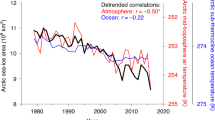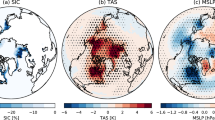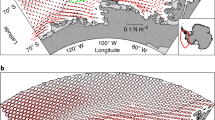Abstract
The Arctic has seen rapid sea-ice decline in the past three decades, whilst warming at about twice the global average rate. Yet the relationship between Arctic warming and sea-ice loss is not well understood. Here, we present evidence that trends in summertime atmospheric circulation may have contributed as much as 60% to the September sea-ice extent decline since 1979. A tendency towards a stronger anticyclonic circulation over Greenland and the Arctic Ocean with a barotropic structure in the troposphere increased the downwelling longwave radiation above the ice by warming and moistening the lower troposphere. Model experiments, with reanalysis data constraining atmospheric circulation, replicate the observed thermodynamic response and indicate that the near-surface changes are dominated by circulation changes rather than feedbacks from the changing sea-ice cover. Internal variability dominates the Arctic summer circulation trend and may be responsible for about 30–50% of the overall decline in September sea ice since 1979.
This is a preview of subscription content, access via your institution
Access options
Access Nature and 54 other Nature Portfolio journals
Get Nature+, our best-value online-access subscription
$29.99 / 30 days
cancel any time
Subscribe to this journal
Receive 12 print issues and online access
$209.00 per year
only $17.42 per issue
Buy this article
- Purchase on Springer Link
- Instant access to full article PDF
Prices may be subject to local taxes which are calculated during checkout




Similar content being viewed by others
References
Min, S. K., Zhang, X. B., Zwiers, F. W. & Agnew, T. Human influence on Arctic sea ice detectable from early 1990s onwards. Geophys. Res. Lett. 35, L21701 (2008).
Kay, J. E., Holland, M. M. & Jahn, A. Inter-annual to multi-decadal Arctic sea ice extent trends in a warming world. Geophys. Res. Lett. 38, L15708 (2011).
Notz, D. & Marotzke, J. Observations reveal external driver for Arctic sea-ice retreat. Geophys. Res. Lett. 39, L08502 (2012).
Stroeve, J., Holland, M. M., Meier, W., Scambos, T. & Serreze, M. Arctic sea ice decline: faster than forecast. Geophys. Res. Lett. 34, L09501 (2007).
Day, J. J., Hargreaves, J. C., Annan, J. D. & Abe-Ouchi, A. Sources of multi-decadal variability in Arctic sea ice extent. Environ. Res. Lett. 7, 034011 (2012).
Rampal, P., Weiss, J., Dubois, C. & Campin, J.-M. IPCC climate models do not capture Arctic sea ice drift acceleration: consequences in terms of projected sea ice thinning and decline. J. Geophys. Res. 116, C00D07 (2011).
Swart, N. C., Fyfe, J. C., Hawkins, E., Kay, J. E. & Jahn, A. Influence of internal variability on Arctic sea-ice trends. Nat. Clim. Change 5, 86–89 (2015).
Zhang, R. Mechanisms for low frequency variability of summer Arctic sea ice extent. Proc. Natl Acad. Sci. USA 112, 1422296112 (2015).
Francis, J. A. & Hunter, E. New insight into the disappearing Arctic sea ice. Eos 87, 509–511 (2006).
Graversen, R. G. & Wang, M. Polar amplification in a coupled climate model with locked albedo. Clim. Dynam. 33, 629–643 (2009).
Chylek, P., Folland, C. K., Lesins, G., Dubey, M. K. & Wang, M.-Y. Arctic air temperature change amplification and the Atlantic multidecadal oscillation. Geophys. Res. Lett. 36, L14801 (2009).
Screen, J. A. & Simmonds, I. The central role of diminishing sea ice in recent Arctic temperature amplification. Nature 464, 1334–1337 (2010).
Serreze, M. C. & Barry, R. G. Processes and impacts of Arctic amplification: a research synthesis. Glob. Planet. Change 77, 85–96 (2011).
Bintanja, R., Graversen, R. & Hazeleger, W. Arctic winter warming amplified by the thermal inversion and consequent low infrared cooling to space. Nat. Geosci. 4, 758–761 (2011).
Vaughan, D. G. et al. in Climate Change 2013: The Physical Science Basis (eds Stocker, T. F. et al.) 317–382 (IPCC, Cambridge Univ. Press, 2013).
Park, H.-S., Lee, S., Kosaka, Y., Son, S.-W. & Kim, S.-W. The impact of Arctic winter infrared radiation on early summer sea ice. J. Clim. 28, 6281–6296 (2015).
Park, D.-S., Lee, S. & Feldstein, S. B. Attribution of the recent winter sea-ice decline over the Atlantic sector of the Arctic Ocean. J. Clim. 28, 4027–4033 (2015).
Screen, J. A., Deser, C. & Simmonds, I. Local and remote controls on observed Arctic warming. Geophys. Res. Lett. 39, L10709 (2012).
Perlwitz, J., Hoerling, M. & Dole, R. Arctic tropospheric warming: causes and linkages to lower latitudes. J. Clim. 28, 2154–2167 (2015).
Deser, C., Walsh, J. E. & Timlin, M. S. Arctic sea ice variability in the context of recent atmospheric circulation trends. J. Clim. 13, 617–633 (2000).
Hu, A., Rooth, C., Bleck, R. & Deser, C. NAO influence on sea ice extent in the Eurasian coastal region. Geophys. Res. Lett. 29, 2053 (2002).
Deser, C. & Teng, H. Evolution of Arctic sea ice concentration trends and the role of atmospheric circulation forcing 1979–2007. Geophys. Res. Lett. 35, L02504 (2008).
Ogi, M., Rigor, I. G., McPhee, M. G. & Wallace, J. M. Summer retreat of Arctic sea ice: role of summer winds. Geophys. Res. Lett. 35, L24701 (2008).
Ogi, M., Yamazaki, K. & Wallace, J. M. Influence of winter and summer surface wind anomalies on summer Arctic sea ice extent. Geophys. Res. Lett. 37, L07701 (2010).
Watanabe, E., Wang, J., Sumi, A. & Hasumi, H. Arctic dipole anomaly and its contribution to sea ice export from the Arctic Ocean in the 20th century. Geophys. Res. Lett. 33, L23703 (2006).
Blanchard-Wrigglesworth, E., Armour, K. C., Bitz, C. M. & DeWeaver, E. Persistence and inherent predictability of Arctic sea ice in a GCM ensemble and observations. J. Clim. 24, 231–250 (2011).
Wettstein, J. J. & Deser, C. Internal variability in projections of twenty-first century Arctic sea ice loss: role of the large-scale atmospheric circulation. J. Clim. 27, 527–550 (2014).
Screen, J. A., Simmonds, I. & Keay, K. Dramatic interannual changes of perennial Arctic sea ice linked to abnormal summer storm activity. J. Geophys. Res. 116, D15105 (2011).
Kay, J. E., L’Ecuyer, T., Gettelman, A., Stephens, G. & O’Dell, C. The contribution of cloud and radiation anomalies to the 2007 Arctic sea ice extent minimum. Geophys. Res. Lett. 35, L08503 (2008).
Francis, J. A. & Hunter, E. Drivers of declining sea ice in the Arctic winter: a tale of two seas. Geophys. Res. Lett. 34, L17503 (2007).
Schweiger, A. J., Lindsay, R. W., Vavrus, S. & Francis, J. A. Relationships between Arctic clouds and sea ice during autumn. J. Clim. 21, 4799–4810 (2008).
Bhatt, U. S. et al. The Atmospheric Response to Realistic Reduced Summer Arctic Sea Ice Anomalies, in Arctic Sea Ice Decline: Observations, Projections, Mechanisms, and Implications (American Geophysical Union, 2008).
Liu, J. P. et al. Has Arctic sea ice loss contributed to increased surface melting of the Greenland ice sheet? J. Clim. 29, 3373–3386 (2016).
Deser, C., Tomas, R., Alexander, M. & Lawrence, D. The seasonal atmospheric response to projected Arctic sea ice loss in the late 21st century. J. Clim. 23, 333–351 (2010).
Taylor, K. E., Stouffer, R. J. & Meehl, G. A. An overview of CMIP5 and the experiment design. Bull. Am. Meteorol. Soc. 93, 485–498 (2012).
Kay, J. E. et al. The Community Earth System Model (CESM) large ensemble project: a community resource for studying climate change in the presence of internal climate variability. Bull. Am. Meteorol. Soc. 96, 1333–1349 (2015).
Hoerling, M. P., Hurrell, J. W. & Xu, T. Y. Tropical origins for recent North Atlantic climate change. Science 292, 90–92 (2001).
Lee, S. Testing of the tropically excited Arctic warming (TEAM) mechanism with traditional El Nino and La Nina. J. Clim. 25, 4015–4022 (2012).
Ding, Q. H. et al. Tropical forcing of the recent rapid Arctic warming in northeastern Canada and Greenland. Nature 509, 209–212 (2014).
Trenberth, K. E., Fasullo, J. T., Branstator, G. & Phillips, A. S. Seasonal aspects of the recent pause in surface warming. Nat. Clim. Change 4, 911–916 (2014).
Liu, Y. & Key, J. Assessment of Arctic cloud cover anomalies in atmospheric reanalysis products using satellite data. J. Clim. 29, 6065–6083 (2016).
Barnes, E. A. & Screen, J. The impact of Arctic warming on the midlatitude jetstream: Can it? Has it? Will it? WIREs Clim. Change 6, 277–286 (2015).
Overland, J. E. & Wang, M. Increased variability in the early winter subarctic North American atmospheric circulation. J. Clim. 28, 7297–7305 (2015).
Francis, J. A. & Skific, N. Evidence linking rapid Arctic warming to mid-latitude weather patterns. Phil. Trans. R. Soc. A 373, 20140170 (2015).
Cohen, J. An observational analysis: tropical relative to Arctic influence on midlatitude weather in the era of Arctic amplification. Geophys. Res. Lett. 43, 5287–5294 (2016).
Zhang, J. & Rothrock, D. A. Modeling global sea ice with a thickness and enthalpy distribution model in generalized curvilinear coordinates. Mon. Weath. Rev. 131, 845–861 (2003).
Dee, D. P. et al. The ERA-Interim reanalysis: configuration and performance of the data assimilation system. Q. J. R. Meteorol. Soc. 137, 553–597 (2011).
Roeckner, E. et al. Max Planck Institut für Meteorologie Report (Max-Planck-Institut für Meteorologie, 2003).
Hurrell, J. W. et al. The community earth system model: a framework for collaborative research. Bull. Am. Meteorol. Soc. 94, 1339–1360 (2013).
Bretherton, C. S., Widmann, M., Dymnidov, V. P., Wallace, J. M. & Blade, I. The effective number of spatial degrees of freedom of a time-varying field. J. Clim. 12, 1990–2009 (1999).
Acknowledgements
This study was supported by NOAA’s Climate Program Office, Climate Variability and Predictability Program (NA15OAR4310162). We thank the Max Planck Institute for Meteorology and National Center for Atmospheric Research model developers for making the ECHAM5 and CESM available and M. Steele, J. M. Wallace, C. Bitz, Q. Fu, M. Wang, D. L. Hartmann and D. Frierson for discussions. We acknowledge the CESM Large Ensemble Community Project and supercomputing resources provided by NSF/CISL/Yellowstone. Q.D. acknowledges support from the University of Washington’s Polar Science Center, the UW-Future of Ice Initiative, the Tamaki Foundation and UCSB Center for Scientific Computing at CNSI. A.S. is grateful for funding from the National Science Foundation through grant ARC-1203425. D.S.B. acknowledges support from the Tamaki Foundation. R.E. acknowledges support from NASA NNXBAQ35G.
Author information
Authors and Affiliations
Contributions
Q.D. led this work with contributions from all authors. Q.D. made the calculations, implemented the general circulation model experiments, created the figures, and led writing of the paper. All authors contributed to the experimental design, interpreting results and writing the paper.
Corresponding author
Ethics declarations
Competing interests
The authors declare no competing financial interests.
Supplementary information
Supplementary Information
Supplementary Information (PDF 2166 kb)
Rights and permissions
About this article
Cite this article
Ding, Q., Schweiger, A., L’Heureux, M. et al. Influence of high-latitude atmospheric circulation changes on summertime Arctic sea ice. Nature Clim Change 7, 289–295 (2017). https://doi.org/10.1038/nclimate3241
Received:
Accepted:
Published:
Issue Date:
DOI: https://doi.org/10.1038/nclimate3241
This article is cited by
-
Projections of an ice-free Arctic Ocean
Nature Reviews Earth & Environment (2024)
-
Recent autumn sea ice loss in the eastern Arctic enhanced by summer Asian-Pacific Oscillation
Nature Communications (2024)
-
Arctic marine heatwaves forced by greenhouse gases and triggered by abrupt sea-ice melt
Communications Earth & Environment (2024)
-
Extremes of summer Arctic sea ice reduction investigated with a rare event algorithm
Climate Dynamics (2024)
-
Projecting Wintertime Newly Formed Arctic Sea Ice through Weighting CMIP6 Model Performance and Independence
Advances in Atmospheric Sciences (2024)



